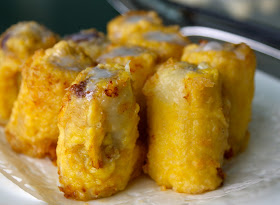I first
heard about it in November of 2011 -- how famed masterchef Chen Xun had been coaxed
out of retirement for a month-long dim sum promotion in Guangzhou. I was not
able to make that trip, and have regretted it since. It was a meal I would have
gladly killed for.
The
Guangzhou-based 87-year-old Chen is regarded as one of the greatest dim sum
masters of his generation. He is advisor to the Guangzhou Culinary Association
and author of many cookbooks.
 |
| 赤绳欣系足 |
So
imagine my surprise and glee when I learned that the masterchef had been
invited to repeat his feat, this time in Hong Kong for two weeks. A few days back I finally
found myself seated at Nanhai No.1 restaurant in Tsimshatsui, looking at dim
sum that had been served by Chen since the 1940s.
We opened
with Steamed Mountain Yam and Duck Web with Bean Curd Skin (right). The duck web had
been braised and steamed along with the yam, allowing the yam, which was tied
together with string made from an omelette, to thoroughly imbibe the flavour of
the duck web. The taste was subtle with a light hint of superior soy sauce.
 |
| 彩风隐龙怀 |
Next
came Steamed Prawn stuffed with Quail Egg (left).
The prawn was minced and beaten into a paste that was smooth and
slightly crunchy. The acid test for me was the taste of prawn, which came
through with light seasoning. The quail egg also gave a heavier body to the
bite.
This
was followed by morsel-sized pastry birds, actually Baked Chicken Liver Pastry
seasoned with Spring Onion Oil (below, left). The liver was light in taste, unlike the heftier
flavour of most chicken liver. The pastry was typically Chinese in style, and a
little on the heavy side with a hint of spring onion oil.
 |
| 葱油凤肝酥 (left), 窝烧鸭脑饼 (right) |
The
fourth item was unusual---Baked Duck’s Brain Pancake with Cinnamon
Flavour (above, right). Each pancake used two duck
brains blended with minced meat. The taste of duck brain was subtle but the
texture was unforgettable. It reminded me of tofu but with a meatier smoked
taste. My favorite!
 |
| 茄汁鲜虾饺 |
When
the ha kou was presented, it looked
like any other ha kou except for a
pronounced red blush shining through the skin. The first bite of the Steamed
Shrimp Dumpling with Fresh Tomato (right) produced a light hint of tomato sourness accompanied
by the crunch of prawn paste. But the
second bite clearly justified the presence of the tomato paste; the flavor of
tomato and prawns is a marriage made in heaven. Yum!
I’ve
never been fond of chicken siu mai (below, right), and the only occasion I would eat chicken
siu mai would be in Muslim Malaysia, where the use of pork in hotel restaurants
is forbidden. But Masterchef Chen Xun’s version was exquisite, the meat finely
chopped and marinated with superior oyster and soy sauces. The meat on its own
was already flavoursome but the marinate enhanced it even further.
 |
| 网油牛肉卷 (left), 鸡茸干蒸卖 (right) |
The Steamed
Beef Ball (above, left) was lean beef hand-chopped, and wrapped in caul-oil which serves to
moisten the meatball during steaming. The beef was further enhanced with dried
mandarin peel, water chestnut, lemon leaves and coriander. From the first bite the
parade of flavours from the ingredients came through, one after another!
 |
| 柚皮火腩夹 |
The
preparation of pomelo skin is always tedious and time-consuming, making pomelo
skin as an ingredient a rare treat in restaurants. Masterchef Chen Xun mixed Pomelo Skin with Pork Belly (left) and cooked it until soft. The final mixture was
then stuffed into a bun and steamed for about 20 minutes, giving it a
refreshing taste quite unlike the usual char siu or chicken bun. Furthermore,
the pomelo skin soaked in the oil from the pork belly, while sending hints of
fruitiness seeping through the meat.
Two
desserts were prepared and served for this promotion. The first was lotus paste
coated with flour mixture and sesame seeds (below, right), and deep-fried until golden brown.
The lotus paste was light and not too sweet like most Chinese desserts. And the
sesame seeds gave a nice bite with a pungent seedy flavor.
 |
| 波渣香麻条 |
The
last dessert was my favourite -- deep-fried Banana stuffed with Red Bean Paste (below, left).
The combination was refreshing and somehow tasted modern. But the restaurant
staff assured me that such a combination had already existed more than 50 years
ago.
NANHAI
NO. 1
Level
30, iSquare
63
Nathan Road
Tsimshatsui,
Kowloon
HONG
KONG
Tel: 852 2487 3688
 |
| 脱衣换锦袍 |














